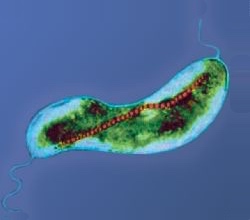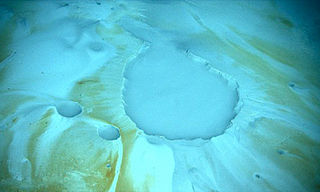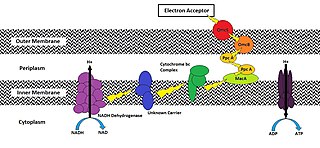Related Research Articles
A taxis is the movement of an organism in response to a stimulus such as light or the presence of food. Taxes are innate behavioural responses. A taxis differs from a tropism in that in the case of taxis, the organism has motility and demonstrates guided movement towards or away from the stimulus source. It is sometimes distinguished from a kinesis, a non-directional change in activity in response to a stimulus.

In oceanography and limnology, the sediment–water interface is the boundary between bed sediment and the overlying water column. The term usually refers to a thin layer of water at the very surface of sediments on the seafloor. In the ocean, estuaries, and lakes, this layer interacts with the water above it through physical flow and chemical reactions mediated by the micro-organisms, animals, and plants living at the bottom of the water body. The topography of this interface is often dynamic, as it is affected by physical processes and biological processes. Physical, biological, and chemical processes occur at the sediment-water interface as a result of a number of gradients such as chemical potential gradients, pore water gradients, and oxygen gradients.
Magnetotaxis is a process implemented by a diverse group of Gram-negative bacteria that involves orienting and coordinating movement in response to Earth's magnetic field. This process is mainly carried out by microaerophilic and anaerobic bacteria found in aquatic environments such as salt marshes, seawater, and freshwater lakes. By sensing the magnetic field, the bacteria are able to orient themselves towards environments with more favorable oxygen concentrations. This orientation towards more favorable oxygen concentrations allows the bacteria to reach these environments faster as opposed to random movement through Brownian motion.

Magnetotactic bacteria are a polyphyletic group of bacteria that orient themselves along the magnetic field lines of Earth's magnetic field. Discovered in 1963 by Salvatore Bellini and rediscovered in 1975 by Richard Blakemore, this alignment is believed to aid these organisms in reaching regions of optimal oxygen concentration. To perform this task, these bacteria have organelles called magnetosomes that contain magnetic crystals. The biological phenomenon of microorganisms tending to move in response to the environment's magnetic characteristics is known as magnetotaxis. However, this term is misleading in that every other application of the term taxis involves a stimulus-response mechanism. In contrast to the magnetoreception of animals, the bacteria contain fixed magnets that force the bacteria into alignment—even dead cells are dragged into alignment, just like a compass needle.

Beggiatoa is a genus of Gammaproteobacteria belonging to the order Thiotrichales, in the Pseudomonadota phylum. This genus was one of the first bacteria discovered by Ukrainian botanist Sergei Winogradsky. During his research in Anton de Bary's laboratory of botany in 1887, he found that Beggiatoa oxidized hydrogen sulfide (H2S) as an energy source, forming intracellular sulfur droplets, oxygen is the terminal electron acceptor and CO2 is used as a carbon source. Winogradsky named it in honor of the Italian doctor and botanist Francesco Secondo Beggiato (1806 - 1883), from Venice. Winogradsky referred to this form of metabolism as "inorgoxidation" (oxidation of inorganic compounds), today called chemolithotrophy. These organisms live in sulfur-rich environments such as soil, both marine and freshwater, in the deep sea hydrothermal vents and in polluted marine environments. The finding represented the first discovery of lithotrophy. Two species of Beggiatoa have been formally described: the type species Beggiatoa alba and Beggiatoa leptomitoformis, the latter of which was only published in 2017. This colorless and filamentous bacterium, sometimes in association with other sulfur bacteria (for example the genus Thiothrix), can be arranged in biofilm visible to the naked eye formed by a very long white filamentous mat, the white color is due to the stored sulfur. Species of Beggiatoa have cells up to 200 µm in diameter and they are one of the largest prokaryotes on Earth.
Microbial metabolism is the means by which a microbe obtains the energy and nutrients it needs to live and reproduce. Microbes use many different types of metabolic strategies and species can often be differentiated from each other based on metabolic characteristics. The specific metabolic properties of a microbe are the major factors in determining that microbe's ecological niche, and often allow for that microbe to be useful in industrial processes or responsible for biogeochemical cycles.
Microbial fuel cell (MFC) is a type of bioelectrochemical fuel cell system that generates electric current by diverting electrons produced from the microbial oxidation of reduced compounds on the anode to oxidized compounds such as oxygen on the cathode through an external electrical circuit. MFCs produce electricity by using the electrons derived from biochemical reactions catalyzed by bacteria. MFCs can be grouped into two general categories: mediated and unmediated. The first MFCs, demonstrated in the early 20th century, used a mediator: a chemical that transfers electrons from the bacteria in the cell to the anode. Unmediated MFCs emerged in the 1970s; in this type of MFC the bacteria typically have electrochemically active redox proteins such as cytochromes on their outer membrane that can transfer electrons directly to the anode. In the 21st century MFCs have started to find commercial use in wastewater treatment.

A brine pool, sometimes called an underwater lake, deepwater or brine lake, is a volume of brine collected in a seafloor depression. The pools are dense bodies of water that have a salinity that is three to eight times greater than the surrounding ocean. Brine pools are commonly found below polar sea ice and in the deep ocean. Those below sea ice form through a process called brine rejection. For deep-sea brine pools, salt is necessary to increase the salinity gradient. The salt can come from one of two processes: the dissolution of large salt deposits through salt tectonics or geothermally heated brine issued from tectonic spreading centers.

Bacteria are ubiquitous, mostly free-living organisms often consisting of one biological cell. They constitute a large domain of prokaryotic microorganisms. Typically a few micrometres in length, bacteria were among the first life forms to appear on Earth, and are present in most of its habitats. Bacteria inhabit soil, water, acidic hot springs, radioactive waste, and the deep biosphere of Earth's crust. Bacteria are vital in many stages of the nutrient cycle by recycling nutrients such as the fixation of nitrogen from the atmosphere. The nutrient cycle includes the decomposition of dead bodies; bacteria are responsible for the putrefaction stage in this process. In the biological communities surrounding hydrothermal vents and cold seeps, extremophile bacteria provide the nutrients needed to sustain life by converting dissolved compounds, such as hydrogen sulphide and methane, to energy. Bacteria also live in symbiotic and parasitic relationships with plants and animals. Most bacteria have not been characterised and there are many species that cannot be grown in the laboratory. The study of bacteria is known as bacteriology, a branch of microbiology.

Shewanella is the sole genus included in the marine bacteria family Shewanellaceae. Some species within it were formerly classed as Alteromonas. Shewanella consists of facultatively anaerobic Gram-negative rods, most of which are found in extreme aquatic habitats where the temperature is very low and the pressure is very high. Shewanella bacteria are a normal component of the surface flora of fish and are implicated in fish spoilage. Shewanella chilikensis, a species of the genus Shewanella commonly found in the marine sponges of Saint Martin's Island of the Bay of Bengal, Bangladesh.

The sea surface microlayer (SML) is the boundary interface between the atmosphere and ocean, covering about 70% of Earth's surface. With an operationally defined thickness between 1 and 1,000 μm (1.0 mm), the SML has physicochemical and biological properties that are measurably distinct from underlying waters. Recent studies now indicate that the SML covers the ocean to a significant extent, and evidence shows that it is an aggregate-enriched biofilm environment with distinct microbial communities. Because of its unique position at the air-sea interface, the SML is central to a range of global marine biogeochemical and climate-related processes.

Shewanella oneidensis is a bacterium notable for its ability to reduce metal ions and live in environments with or without oxygen. This proteobacterium was first isolated from Lake Oneida, NY in 1988, hence its name.

Bacterial motility is the ability of bacteria to move independently using metabolic energy. Most motility mechanisms which evolved among bacteria also evolved in parallel among the archaea. Most rod-shaped bacteria can move using their own power, which allows colonization of new environments and discovery of new resources for survival. Bacterial movement depends not only on the characteristics of the medium, but also on the use of different appendages to propel. Swarming and swimming movements are both powered by rotating flagella. Whereas swarming is a multicellular 2D movement over a surface and requires the presence of surfactants, swimming is movement of individual cells in liquid environments.

A microbial mat is a multi-layered sheet of microorganisms, mainly bacteria and archaea, or bacteria alone. Microbial mats grow at interfaces between different types of material, mostly on submerged or moist surfaces, but a few survive in deserts. A few are found as endosymbionts of animals.
A biobattery is an energy storing device that is powered by organic compounds. Although the batteries are still being tested before being commercially sold, several research teams and engineers are working to further advance the development of these batteries.

Bacterial nanowires are electrically conductive appendages produced by a number of bacteria most notably from the Geobacter and Shewanella genera. Conductive nanowires have also been confirmed in the oxygenic cyanobacterium Synechocystis PCC6803 and a thermophilic, methanogenic coculture consisting of Pelotomaculum thermopropionicum and Methanothermobacter thermoautotrophicus. From physiological and functional perspectives, bacterial nanowires are diverse. The precise role microbial nanowires play in their biological systems has not been fully realized, but several proposed functions exist. Outside of a naturally occurring environment, bacterial nanowires have shown potential to be useful in several fields, notably the bioenergy and bioremediation industries.

An exoelectrogen normally refers to a microorganism that has the ability to transfer electrons extracellularly. While exoelectrogen is the predominant name, other terms have been used: electrochemically active bacteria, anode respiring bacteria, and electricigens. Electrons exocytosed in this fashion are produced following ATP production using an electron transport chain (ETC) during oxidative phosphorylation. Conventional cellular respiration requires a final electron acceptor to receive these electrons. Cells that use molecular oxygen (O2) as their final electron acceptor are described as using aerobic respiration, while cells that use other soluble compounds as their final electron acceptor are described as using anaerobic respiration. However, the final electron acceptor of an exoelectrogen is found extracellularly and can be a strong oxidizing agent in aqueous solution or a solid conductor/electron acceptor. Two commonly observed acceptors are iron compounds (specifically Fe(III) oxides) and manganese compounds (specifically Mn(III/IV) oxides). As oxygen is a strong oxidizer, cells are able to do this strictly in the absence of oxygen.

Mariprofundus ferrooxydans is a neutrophilic, chemolithotrophic, Gram-negative bacterium which can grow by oxidising ferrous to ferric iron. It is one of the few members of the class Zetaproteobacteria in the phylum Pseudomonadota. It is typically found in iron-rich deep sea environments, particularly at hydrothermal vents. M. ferrooxydans characteristically produces stalks of solid iron oxyhydroxides that form into iron mats. Genes that have been proposed to catalyze Fe(II) oxidation in M. ferrooxydans are similar to those involved in known metal redox pathways, and thus it serves as a good candidate for a model iron oxidizing organism.
Dissimilatory metal-reducing microorganisms are a group of microorganisms (both bacteria and archaea) that can perform anaerobic respiration utilizing a metal as terminal electron acceptor rather than molecular oxygen (O2), which is the terminal electron acceptor reduced to water (H2O) in aerobic respiration. The most common metals used for this end are iron [Fe(III)] and manganese [Mn(IV)], which are reduced to Fe(II) and Mn(II) respectively, and most microorganisms that reduce Fe(III) can reduce Mn(IV) as well. But other metals and metalloids are also used as terminal electron acceptors, such as vanadium [V(V)], chromium [Cr(VI)], molybdenum [Mo(VI)], cobalt [Co(III)], palladium [Pd(II)], gold [Au(III)], and mercury [Hg(II)].
Electrotaxis, also known as galvanotaxis, is the directed motion of biological cells or organisms guided by an electric field or current. The directed motion of electrotaxis can take many forms, such as; growth, development, active swimming, and passive migration. A wide variety of biological cells can naturally sense and follow DC electric fields. Such electric fields arise naturally in biological tissues during development and healing. These and other observations have led to research into how applied electric fields can impact wound healing An increase in wound healing rate is regularly observed and this is thought to be due to the cell migration and other signaling pathways that are activated by the electric field. Additional research has been conducted into how applied electric fields impact cancer metastasis, morphogenesis, neuron guidance, motility of pathogenic bacteria, biofilm formation, and many other biological phenomena.
References
- 1 2 3 4 Stricker, Laura; Guido, Isabella; Breithaupt, Thomas; Mazza, Marco G.; Vollmer, Jürgen (2020-10-28). "Hybrid sideways/longitudinal swimming in the monoflagellate Shewanella oneidensis: from aerotactic band to biofilm". Journal of the Royal Society Interface. 17 (171): 20200559. doi:10.1098/rsif.2020.0559. PMC 7653395 . PMID 33109020.
- ↑ Hölscher, Theresa; Bartels, Benjamin; Lin, Yu-Cheng; Gallegos-Monterrosa, Ramses; Price-Whelan, Alexa; Kolter, Roberto; Dietrich, Lars E. P.; Kovács, Ákos T. (2015-11-20). "Motility, chemotaxis and aerotaxis contribute to competitiveness during bacterial pellicle biofilm development". Journal of Molecular Biology. 427 (23): 3695–3708. doi:10.1016/j.jmb.2015.06.014. ISSN 0022-2836. PMC 4804472 . PMID 26122431.
- ↑ Mazzag, B. C.; Zhulin, I. B.; Mogilner, A. (2003-12-01). "Model of Bacterial Band Formation in Aerotaxis". Biophysical Journal. 85 (6): 3558–3574. doi:10.1016/S0006-3495(03)74775-4. ISSN 0006-3495. PMC 1303662 . PMID 14645050.
- ↑ Taylor, Barry L.; Zhulin, Igor B.; Johnson, Mark S. (1999-10-01). "Aerotaxis and Other Energy-Sensing Behavior in Bacteria". Annual Review of Microbiology. 53 (1): 103–128. doi:10.1146/annurev.micro.53.1.103. ISSN 0066-4227. PMID 10547687.
- ↑ Popp, Felix; Armitage, Judith P.; Schüler, Dirk (2014-11-14). "Polarity of bacterial magnetotaxis is controlled by aerotaxis through a common sensory pathway". Nature Communications. 5 (1): 5398. doi: 10.1038/ncomms6398 . ISSN 2041-1723. PMID 25394370.